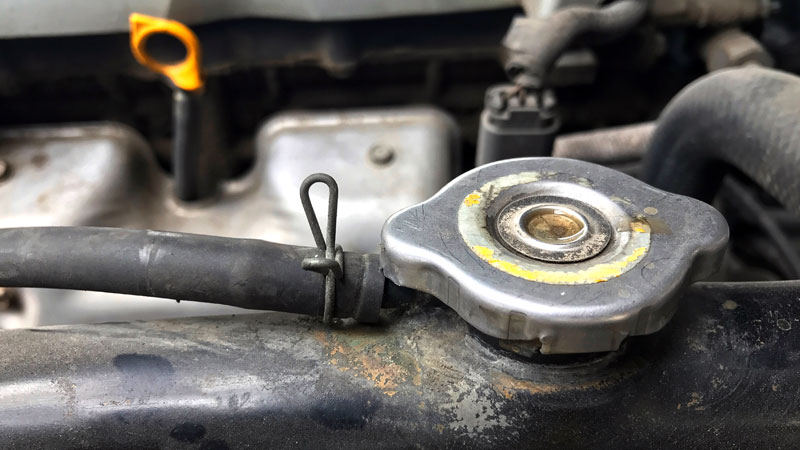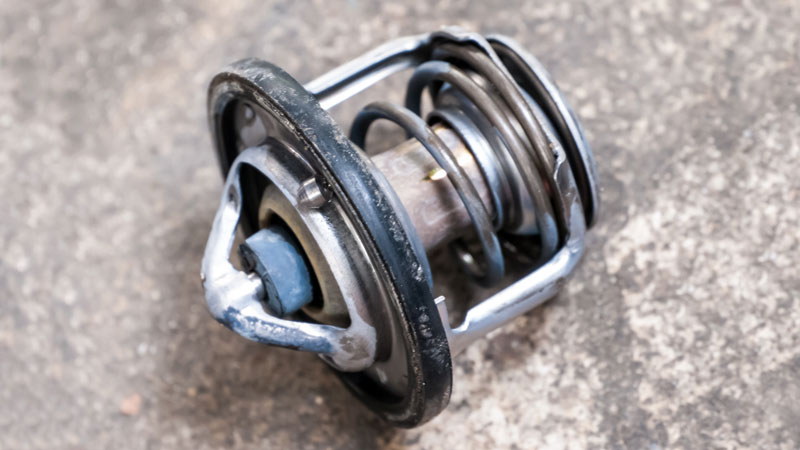A collapsed radiator hose is a hose in the cooling system that appears to be pinched or squeezed in the middle.
While the hose may still hold coolant, a pinched hose is put under stresses it was not designed for. It’s important to figure out why a hose is being pinched so that hose does not weaken over time.
A ruptured radiator hose could leave you with an engine that has no coolant. This could cause engine overheating and even leave you stranded.
Causes of Radiator Hose Collapse
As your engine heats up, engine coolant expands and the system pressurizes. Excess coolant is moved into the overflow reservoir.
As the engine cools, pressure in the radiator decreases. This draws coolant out of the overflow reservoir back into the radiator.
Radiator hoses typically collapse due to vacuum in the cooling system. It is rare to see a radiator hose collapse on acceleration, and this issue is likely most visible right after the engine cools. A radiator hose can collapse for a number of reasons.
1) Bad Radiator Cap

The process of transferring coolant between the overflow reservoir and the radiator is controlled by two springs inside the radiator cap. A bad radiator cap can prevent coolant from returning to the radiator from the overflow reservoir as the engine cools.
Radiator caps are cheap and simple to replace, so this is an easy thing to try if you’re noticing problems with your cooling system.
Do not attempt to remove the radiator cap while the engine is warm. The cooling system is pressurized, and the engine coolant is hot enough to scald you!
2) Clogged Overflow Reservoir

If the passage from overflow reservoir to the radiator is blocked, the symptoms will appear very similar to those you would see with a bad radiator cap. Check the cooling hose that connects the radiator to the overflow reservoir.
Replace the hose if it is damaged or clogged.
3) Incorrect Coolant Hose Shape

A generic cooling hose from a parts store may be able to get you by if you can’t find the correct hose. However, some generic replacement hoses don’t quite have the same bends and angles as the original hoses.
If you have to bend a hose too far, it may appear to be collapsed, even if the hose is technically fine. If you bought a vehicle with a hose that appears to be collapsed, perhaps the hose is simply the wrong shape for the vehicle.
Should I Be Able to Squeeze the Radiator Hose?
Since a healthy coolant hose is made of rubber, you should be able to squeeze the hose a little bit.
If the radiator hose feels excessively spongy or rock hard, it’s probably time to replace the hose. Rubber hoses wear out over time. The rubber will either soften or harden to the point where they are in danger of rupturing.
Radiator Pressure Test

Radiator hose damage can be subtle, and you may only notice a leak once the system is pressurized. A radiator pressure test can help you diagnose this type of leak.
During a radiator pressure test, a tester with a gauge is hooked up to the radiator filler neck. The tester is then pumped up to the pressure the system is rated for (for instance, 14 psi on a 14 psi cooling system). The cooling system is then inspected for leaks.
If you opt to perform this test yourself, make sure you are not over pressurizing the cooling system. Doing so could put more stress on the radiator and hoses than they were designed for. This could cause even healthy components to rupture.
Are Both Radiator Hoses Supposed to Be Hot?
Eventually, both radiator hoses should be warm or hot.
As your car is warming up, you will notice that only one radiator hose gets hot. This is because the thermostat is closed. The thermostat closes off the coolant in the block so it heats up faster, which helps the engine come up to operating temperature as quickly as possible.
Once your engine reaches operating temperature and starts to warm up even more, the thermostat will open. This allows ambient temperature coolant in the radiator to enter the engine block. When this happens, the other radiator hose will heat up.
On some cooling systems, the upper radiator hose is the last hose to warm up. On other systems, it is the lower radiator hose. This depends on the engine and the direction the coolant circulates.
Each engine is a little different, so you should look up details for your specific cooling system if you are trying to troubleshoot an issue.
Can Radiator Hose Collapse Cause Overheating?
A collapsed radiator hose is not generally related to overheating. However, an obstruction in the cooling system that prevents the passage of coolant could cause the vehicle to overheat.
Radiator Hose Replacement Cost
We recommend Parts Geek for the best prices and selection.

Radiators hoses are very cheap, ranging from $5 to $50 per hose. If you are doing this job yourself, you will only have to pay for the cost of the hose, and additional coolant if you choose not to catch and reuse your coolant during the repair.
Larger engines such as the Duramax diesel may cost a bit more to replace the hoses.
Taking this job to a shop is also relatively inexpensive, ranging from $100-300 depending on which hose needs replacing and the accessibility of that hose.
- SVC Audio: Highway Hero or Unnecessary Distraction? - May 1, 2024
- 5 Most Common Car Repairs in the US (And Average Cost) - April 23, 2024
- Cars with an LS3 Engine (And Why They’re So Popular) - March 26, 2024


